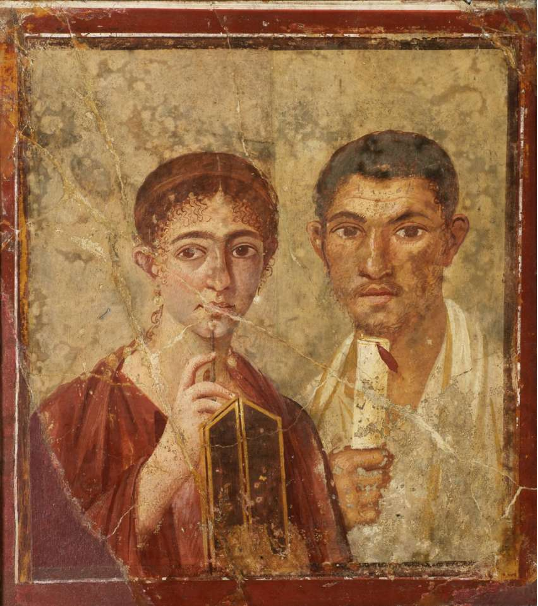2.a When did it all start? | 20 Min

Image credit: Portrait of Terentius Neo, ca. 20-30 CE, Naples National Archaeological Museum. Public domain image.
Watch this TEDx Talk by journalist and computer scientist Tom Standage (16 min), author of “Writing on the Wall”, a short history of information sharing. Standage defines social media as media exchanged between people along social connections and creating a distributed discussion or community. In his talk, he argues that a number of historical periods and events have the same type of communication structure as present-day social media. He goes so far as to regard the era of traditional analogue media - radio, television, and film - as an exception to the practice of passing on information at a low cost that can be modified from one peer to another. In his view, the twenty-first century is a “return” to the communication structures that were common before the technological innovations of the nineteenth and twentieth centuries.
In the table below, the key points of this oral presentation are listed. Your task is to check Standage’s claims about social media being the continuation of an old practice by complementing the table with the examples that he gives of social media in the past. Try to determine whether the features of the ancient social media that Standage discusses are similar or different to contemporary ones.
| Content | Time Period and Geographic Area | Social Medium | Technologies Applied |
|---|---|---|---|
| Wax tablets and scrolls | |||
| Pamphlets | |||
| Coffeehouses | |||
| Radio broadcasts | |||
| Film recording of a lecture with slides by a renowned scholar on the topic of technology and communication (16 min) | Performed 1-6-2013 at the Oxford Said Business School and published online on 19-8-2013 | Shared via the video sharing platform YouTube | Recording of lecture with digital film camera; uploading of recording file to one of YouTube’s servers via a personal computer; delivery of video to a viewer’s personal computer from one of YouTube’s servers when the video is selected for viewing* |
*This is a simplification of the technological processes involved in uploading and viewing a YouTube video. For more detailed information on these processes, check out this 2016 infographic from How It Works.
2.b Different views on the beginning of social media | 25 Min
Read this concise history on the origins of social media, offered as part of an online course for bachelor students of marketing at Maryville University in St. Louis, Missouri (USA), and answer the following questions:
- What was the first form of social media, according to the definition of social media referred to in this article?
- According to the author, what have been the two major shifts with regard to users/audiences who engage with social media and the devices through which they communicate?
Now read a different version of the history of social media, this time published on the platform History Cooperative by Matthew Jones on 16 June 2015 and answer the following question:
- Which two key elements are different in Jones’ interpretation of the phenomenon of social media compared to the one offered by Maryville University?